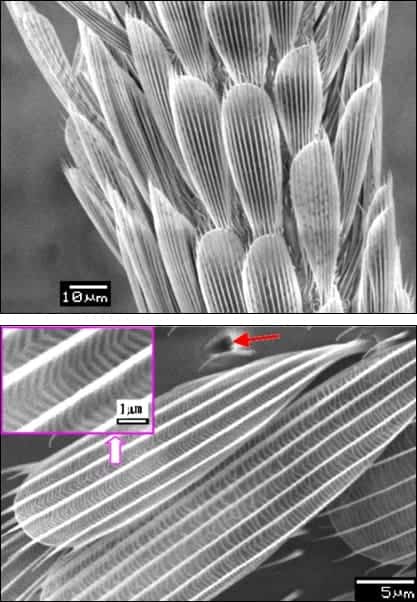Mosquitoes can stick to walls and windows like flies, and happily land and walk on water like pond skaters. Although entomologists have known about this unique ability for years, they weren't exactly sure how it was done. Now, by performing experiments on mosquito legs, physicists from China have discovered that these insects are even more adept at sitting on water than pond skaters (Phys. Rev. E. 76 017301).

Scientists know pond skaters stay afloat because of a special “hairy” nanostructure on their legs that holds pockets of air. These prevent the legs from ever getting wet, thus allowing the insects to be propped up on water’s surface tension. Flies, on the other hand, are adept at clinging vertically or upside down to smooth surfaces, using either bristles that produce attractive forces or claws on their feet.
To see if mosquitoes exploit a similar nanostructure to pond skaters for landing on water, a group led by Chengwei Wu from the Dalian University of Technology in China used a scanning electron microscope (SEM) to examine the six legs, between 5 and 7 mm in length, of mosquitoes caught in their local area.
In addition to claws for clinging to surfaces, they found that the legs were covered in a profusion of scales, of which each was adorned with six to twelve randomly-spaced ridges with a thickness of about 200 nm. These ridges were linked by many smaller “ribs” with a thickness of 100 nm.
Wu’s team thought that, like pond skaters, air would be contained in the gaps created between these ridges and ribs to make the legs stay afloat in water. To see if this was right, they connected the severed leg from a mosquito to a moveable steel needle, and positioned it over a container of water sitting on a force balance. They then inclined the leg to a 30° angle – roughly the angle that would be used for landing – and pushed it against the water’s surface.
Surprisingly, the researchers found that the leg resisted with a force of up to 600 µN – roughly 23 times the mosquito’s body weight – before breaking the surface. In contrast, a pond skater can only receive a force equal to 15 times its body weight through its legs. A common fly, the researchers later found, could barely support its own body weight at all. This more refined water-repelling nanostructure could provide greater stability when mosquitoes land on the surface of water.
To check whether the ability was not simply a result of a low-density – that is, more buoyant – material, Wu’s team repeated the experiment with the leg pitched vertically, which would prevent any air from being trapped. As expected, the force from the leg was heavily reduced, almost by a factor of 50.
Mosquitoes do not have the best reputation. Although in developed nations their damage tends to be limited to itchy bites, in the third world they cause millions of deaths each year by spreading malaria. “Most of the previous studies on mosquitoes were focused on the harmful sides that they bring to human beings,” said the researchers. They added that among the special skills of the mosquitoes, the water-repelling ability “might be the most surprising.”



